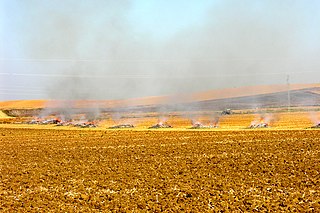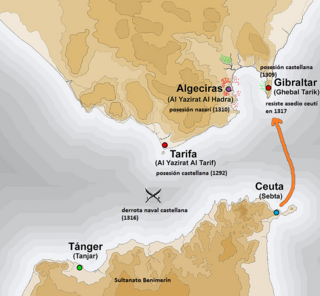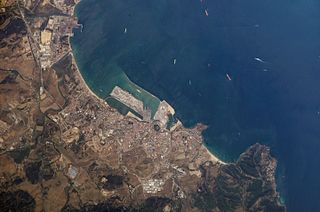Political situation of the Strait of Gibraltar (1274–1350)
- 1274 to 1306.
- 1306 to 1310.
- 1310 to 1329.
- 1329 to 1350.
The Battle of the Strait (Spanish : Batalla del Estrecho) was a military conflict contesting the ports in the Straits of Gibraltar taking place in the late thirteenth century and the first half of the fourteenth. The conflict involves principally the Spanish Muslim Emirate of Granada, the Spanish Christian Crown of Castile and the North African Muslim Marinid state. The ports' strategic value came from their position linking Spain and North Africa, thus connecting Muslims in Spain with the rest of the Islamic world. [1] [2] The campaign had mixed results. Castile gained Tarifa permanently, and managed to take Gibraltar and Algeciras but both would revert to Muslim rule. Castile also failed to gain any port in the African side of the strait. [3]
In the late thirteen and early fourteenth centuries, Castile, the Marinids of Morocco and the Nasrids of Granada fought for the control of the Strait of Gibraltar. This "battle" (Spanish : la Cuestión del Estrecho) is a major chapter in the history of the Christian reconquest of Spain. It was within this framework of clashes between said powers to bring under control such a strategic area when Gibraltar definitely appeared on the scene.
With the implosion of the Almohad Caliphate and the Reconquista onslaught of the 1220–40s, the north shore of the Strait of Gibraltar came under the jurisdiction of the Nasrid Emirate of Granada, a reduced successor state to al-Andalus. As a dependency of nearby Algeciras, Gibraltar was probably given along with Algeciras in 1274, by the Nasrid sultan Muhammad II to Abu Yusuf Yaqub, the Marinid sultan of Morocco, as payment for his intervention in Spain on Granada's behalf against Castilian encroachments. [4] (other sources mention 1275 as the date when the Sultan of Granada handed over Tarifa, Algeciras and Gibraltar to the Marinids for their use as base ports). [5] In 1292, in his pursuit of controlling the Strait, the troops of Sancho IV of Castile laid siege to Tarifa and easily took it. Under the governorship of Guzmán el Bueno, "the Good", Tarifa was unsuccessfully besieged by the Marinids two years later. As a result, the North African rulers decided to retreated to Magreb and sell their remaining ports to the sultans of Granada. [6]
Although no documentary account of Gibraltar is available for the period following the Madinat al-Fath project, there are reasons to believe that a small fortified town existed in Gibraltar, and that its existence was the direct consequence of the fall of Tarifa in 1292. After the capture of the city, it was expected that Sancho would lay siege to Algeciras (it did not eventually happen) in order to sever the most direct links of the Marinids with the Iberian peninsula. The threatening presence of a Christian stronghold to the west would have led to the establishment of a garrison to the east of Algeciras. That way, Gibraltar would have protected the rearguard of Algeciras and provide a fallback position should Algeciras have fallen. At the same time, and with the increased presence of the Christian fleets in the Straits, Gibraltar provided an excellent lookout post. [7]
Some years after the events in Tarifa, a quarrel erupted between the Marinids and the Nasrids, in 1306. The Nasrids promptly sponsored the rebellion of Uthman ibn Idris, a pretender to the Marinid throne in Morocco. Uthman was landed by a Nasrid force in Ceuta, and quickly carved out an enclave. The rebels continued to receive support across the strait from the Nasrid garrisons. It is believed that the Marinid sultan Abu al-Rabi Sulayman, unable to dislodge the rebel from Ceuta, intrigued with the Castilians, whose truce with Granada was about to expire, encouraging them to take Algeciras and Gibraltar and cut the rebel off.[ citation needed ] The first siege of Gibraltar was a side-operation of the main Castilian siege of Algeciras in 1309–1310.
The siege was brief. It seems clear that the defences of Madinat al-Fath were lacking as the Castilians succeeded in capturing Gibraltar in 1309. [8] The Castilian account of the First Siege of Gibraltar indicates that it was only a small place, with "one thousand one hundred and twenty-five Moors" within at the time of its fall. [9] Only two siege engines and a few hundred men were needed to reduce it. After the conquest and the expulsion of the town's population, Ferdinand IV of Castile ordered the defences to be strengthened with the walls repaired, a keep constructed above the town and a dockyard (atarazana) to be built to house galleys. [10] However, the main siege of Algeciras failed, and the Castilians struck a deal with the Granadan sultan allowing them to hold on to Gibraltar.[ citation needed ]
The loss of Gibraltar led to the deposition of the Nasrid sultan of Granada by his brother Nasr, who quickly reversed policy, abandoned the rebels in Ceuta and gave Algeciras (and thus the claim on Gibraltar) to the Marinids in 1310, as part of a new treaty, hoping they might recover it.[ citation needed ] But too busy elsewhere for any entanglements in Spain, the Marinids gave Algeciras back to Granada almost immediately after. The Granadans launched an attempt to recover Gibraltar by themselves in 1315, but without Marinid support, the Second Siege of Gibraltar faltered and failed. [11]
The Castilians held Gibraltar for over twenty years, until a new deal was struck in 1333 between the Nasrid sultan Muhammad IV of Granada and the Marinid sultan Abu al-Hasan Ali ibn Othman of Morocco. Moroccan forces crossed the strait to Algeciras and began the third siege of Gibraltar in 1333. This was a much more serious effort, lasting four and a half months, and was mounted by a combined Granadan-Moroccan force. [12] The population of Spanish Christians was reduced to eating their own shoes and belts before the town's governor, Vasco Pérez de Meira, surrendered on 17 June 1333. [13] However, Muhammad IV was assassinated almost immediately after, in a conspiracy organized by enemies of the Marinids in the Granadan court. The Marinid sultan Abu al-Hasan retained both Algeciras and Gibraltar in Moroccan hands.
The Castilians immediately mounted an unsuccessful fourth siege which ended after two months. Following the restoration of peace, Abu al-Hasan ordered a refortification of Gibraltar "with strong walls as a halo surrounds the crescent moon". [11] Many details of the rebuilt city are known due to the work of Abu al-Hasan's biographer, Ibn Marzuq, whose Musnad (written around 1370–1) describes the reconstruction of Gibraltar. The city was expanded, and a new defensive wall was built to cover the western and southern flanks, with towers and connecting passages added to strengthen them. The existing fortifications were also strengthened and repaired. The weak points that the Castilians had exploited were improved. [8]

The Battle of Río Salado also known as the Battle of Tarifa was a battle of the armies of King Afonso IV of Portugal and King Alfonso XI of Castile against those of Sultan Abu al-Hasan 'Ali of the Marinid dynasty and Yusuf I of Granada.

Abu Al-Hasan 'Ali ibn 'Othman, was a sultan of the Marinid dynasty who reigned in Morocco between 1331 and 1348. In 1333 he captured Gibraltar from the Castilians, although a later attempt to take Tarifa in 1339 ended in fiasco. In North Africa he extended his rule over Tlemcen and Hafsid Ifriqiya, which together covered the north of what is now Algeria and Tunisia. Under him the Marinid realms in the Maghreb briefly covered an area that rivalled that of the preceding Almohad Caliphate. However, he was forced to retreat due to a revolt of the Arab tribes, was shipwrecked, and lost many of his supporters. His son Abu Inan Faris seized power in Fez. Abu Al-Hasan died in exile in the High Atlas mountains.
Muhammad II was the second Nasrid ruler of the Emirate of Granada in Al-Andalus on the Iberian Peninsula, succeeding his father, Muhammad I. Already experienced in matters of state when he ascended the throne, he continued his father's policy of maintaining independence in the face of Granada's larger neighbours, the Christian kingdom of Castile and the Muslim Marinid state of Morocco, as well as an internal rebellion by his family's former allies, the Banu Ashqilula.
Muhammad III was the ruler of the Emirate of Granada in Al-Andalus on the Iberian Peninsula from 8 April 1302 until 14 March 1309, and a member of the Nasrid dynasty. He ascended the Granadan throne after the death of his father Muhammad II, which according to rumours, was caused by Muhammad III poisoning him. He had the reputation of being both cultured and cruel. Later in his life, he became visually impaired—which caused him to be absent from many government activities and to rely on high officials, especially the powerful Vizier Ibn al-Hakim al-Rundi.
Nasr, full name Abu al-Juyush Nasr ibn Muhammad, was the fourth Nasrid ruler of the Emirate of Granada from 14 March 1309 until his abdication on 8 February 1314. He was the son of Muhammad II al-Faqih and Shams al-Duha. He ascended the throne after his brother Muhammad III was dethroned in a palace revolution. At the time of his accession, Granada faced a three-front war against Castile, Aragon and the Marinid Sultanate, triggered by his predecessor's foreign policy. He made peace with the Marinids in September 1309, ceding to them the African port of Ceuta, which had already been captured, as well as Algeciras and Ronda in Europe. Granada lost Gibraltar to a Castilian siege in September, but successfully defended Algeciras until it was given to the Marinids, who continued its defense until the siege was abandoned in January 1310. James II of Aragon sued for peace after Granadan defenders defeated the Aragonese siege of Almería in December 1309, withdrawing his forces and leaving the Emirate's territories by January. In the ensuing treaty, Nasr agreed to pay tributes and indemnities to Ferdinand IV of Castile and yield some border towns in exchange for seven years of peace.
Abu'l-Walid Ismail I ibn Faraj was the fifth Nasrid ruler of the Emirate of Granada on the Iberian Peninsula from 1314 to 1325. A grandson of Muhammad II on the side of his mother Fatima, he was the first of the lineage of sultans now known as the al-dawla al-isma'iliyya al-nasriyya. Historians characterise him as an effective ruler who improved the emirate's position with military victories during his reign.

Abu al-Hajjaj Yusuf ibn Ismail, known by the regnal name al-Muayyad billah, was the seventh Nasrid ruler of the Emirate of Granada on the Iberian Peninsula. The third son of Ismail I, he was Sultan between 1333 and 1354, after his brother Muhammad IV was assassinated.
Abu Abdullah Muhammad ibn Ismail, known as Muhammad IV, was the ruler of the Emirate of Granada on the Iberian Peninsula from 1325 to 1333. He was the sixth sultan of the Nasrid dynasty, succeeding to the throne at ten years old when his father, Ismail I, was assassinated.

The Emirate of Granada, also known as the Nasrid Kingdom of Granada, was an Islamic polity in the southern Iberian Peninsula during the Late Middle Ages, ruled by the Nasrid dynasty. It was the last independent Muslim state in Western Europe.

Abu Yaqub Yusuf an-Nasr was a Marinid ruler of Morocco. He was the son of Abu Yusuf Ya'qub, whom he succeeded in 1286. His mother was a sharifa, Lalla Oum'el'Iz bint Mohammed al-Alaoui. He was assassinated in 1307.

The Battle of Écija was a battle of the Spanish Reconquista that took place on 8 September 1275. The battle pitted the Muslim troops of the Marinids and its allies against those of the Kingdom of Castile and resulted in a Marinid victory.

The second siege of Gibraltar was an abortive attempt in 1316 by the forces of the Azafid Ceuta and the Nasrid Emirate of Granada to recapture Gibraltar, which had fallen to the forces of Ferdinand IV of Castile in 1309.

The history of Moorish Gibraltar began with the landing of the Muslims in Hispania and the fall of the Visigothic Kingdom of Toledo in 711 and ended with the fall of Gibraltar to Christian hands 751 years later, in 1462, with an interregnum during the early 14th century.
The third siege of Gibraltar was mounted between February–June 1333 by a Moorish army under the prince Abd al-Malik Abd al-Wahid of Morocco. The fortified town of Gibraltar had been held by Castile since 1309, when it had been seized from the Moorish Emirate of Granada. The attack on Gibraltar was ordered by the recently crowned Marinid ruler Abu al-Hasan Ali ibn Othman in response to an appeal by the Nasrid ruler Muhammed IV of Granada. The onset of the siege took the Castilians by surprise. The stocks of food in Gibraltar were heavily depleted at the time due to the thievery of the town's governor, Vasco Perez de Meira, who had looted the money that was meant to have been spent on food for the garrison and to pay for the upkeep of the castle and fortifications. After over four months of siege and bombardment by Moorish catapults, the garrison and townspeople were reduced to near-starvation and surrendered to Abd al-Malik.
Abu Malik Abd al-Wahid was a son of the Marinid sultan of Morocco, Abu al-Hasan Ali ibn Othman. Although he had lost an eye, Malik was a capable military commander and served as governor of Algeciras and the Marinids' principal general in Al Andalus. He captured Gibraltar from Castile in June 1333 and participated in his father's campaign against rebels in the Kingdom of Tlemcen the following year. He was killed by Castilian forces in 1339 after being ambushed on the way back from a raid against the Castilian-held town of Jerez de la Frontera.
The sixth siege of Gibraltar in 1411 was the only occasion on which control of Gibraltar was contested between two Islamic powers. After the failed fifth siege of Gibraltar in 1349–50, which ended with the death of King Alfonso XI of Castile from bubonic plague, the Kingdom of Castile was preoccupied with the Castilian Civil War and its aftermath. In 1369, Sultan Muhammed V of Granada took advantage of the Castilians' distractions and in the siege of Algeciras (1369) he seized the city of Algeciras, on the west side of the Bay of Gibraltar, which Alfonso XI had captured in 1344. After razing it to the ground he made peace with Henry II, the winner of the civil war. The truce was renewed by Henry's successors John I and Henry III. At some point during the truces, control of Gibraltar was transferred from the Marinid dynasty of Morocco, which had held it since 1333, to the Granadans. It is not clear why this happened; it may have been as a condition of the Granadans assisting the Marinids against rebels in Morocco.

The siege of Algeciras (1342–1344) was undertaken during the Reconquest of Spain by the Castillian forces of Alfonso XI assisted by the fleets of the Kingdom of Aragon and the Republic of Genoa. The objective was to capture the Muslim city of Al-Jazeera Al-Khadra, called Algeciras by Christians. The city was the capital and the main port of the European territory of the Marinid Empire.
The siege of Almería was an unsuccessful attempt by Aragon to capture the city of Almería from the Emirate of Granada in 1309. Almería, a Mediterranean port in the southeast of the emirate, was the initial Aragonese target in a joint Aragonese-Castilian campaign aimed at conquering Granada. The Aragonese troops led by their King James II arrived on 11 August, blockading the city and employing siege engines. The city, led by governor Abu Maydan Shuayb and naval commander Abu al-Hasan al-Randahi, prepared for the siege by strengthening its defenses and stockpiling food. Throughout the siege, both sides exchanged shots from siege engines and engaged in fields battles and skirmishes with varying results. James ordered multiple unsuccessful assaults. A Granadan relief column under Uthman ibn Abi al-Ula arrived nearby in September and harassed the besiegers.
Abu Sa'id Uthman ibn Abi al-Ula was a Marinid prince who led an unsuccessful rebellion aiming to capture the throne, and fled to the Nasrid Emirate of Granada in its aftermath. There he served as the Commander of the Volunteers of the Faith of Granada, and became one of the most important political figures of the Nasrid realm.